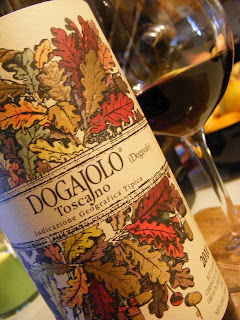recently purchasing a bottle for myself so I could get a better feel for the wine. River Rock White hales from southern Oregon and is a unique blend of 62% early Muscat & 38% Viognier. There was not a date printed on the bottle so if I were to guess I would say this wine is a 2008 after researching the winery a bit.
Fermented in stainless steel casks to retain it's luscious crisp fruit and mouth watering aromas this wine has never seen wood. At $12 per bottle this wine is quite a find and well worth it! I think this would be a great transitional wine for those friends who profess to only like sweet wine. I plan to test this theory. This wine was a Silver Medal winner at North West Wine Summit and a took the Bronze Medal at San Fransisco International Wine Competition.
The color is pale, almost clear with a slight tinge of green. The aromas of sweet flowers, melon and honeysuckle. On the palate you might expect overly sweet as this wine is 62% muscat but on the contrary it's very nice with good acidity. Flavors of melon, asian pear, white peaches and just a slight hint of Kiwi and a kiss of sweet. This wine is refreshing and juicy, wonderful for a hot summer day all by itself or with a chicken salad. It's a well rounded wine, very smooth with a nice finish.
For more information on the Rock Point Winery vist their website at http://rockpointwines.com/index.php
Grape Tidbits:
Early Muscat, bred as a table grape in California, has been successfully used to make wine in Oregon. Muscat is the only grape to produce wine with the same aroma as the grape itself. The Muscat grape is the world's oldest known grape variety. Ripens early, about 3 weeks before Concord. It probably originated in Greece but maybe the independent sultanate of Muscat in the south-east of the Arabian Peninsula had something to do with it. No doubt a Roman soldier or traders brought it through Italy into Roman France. Early records show it shipped from the port of Frontignan in SW France during Charlemagne's also known as Charles the Great (Emporer of the Romans) reign.
Over 200 different varieties and derivatives to the Muscat family exist today. Muscat grapes range from white to almost black in color. The most commonly known varieties of muscat grapes are
- Muscat Blanc à Petits Grains This grape is used for the wine asti spumante
- Moscato Giallo (or Goldmuskateller) and Moscato Rosa are thought to be closely related coloured versions of Muscat Blanc à Petits Grains.
- Muscat of Alexandria (also called Moscatel, Moscatel Romano) This grape is used for sherry (and is one of only three permitted grape varieties to be used in a true Sherry) also as a raisin and table grape
- Muscat Ottonel (also called Moskately) Used for dessert wines in Austria
- Muscat Hamburg (also called Black Muscat) Used for some Eastern European wine but mainly for table grapes in Italy and Australia
- Orange Muscat Used for some wines in California, you may have seen an increase in Orange Moscato.












